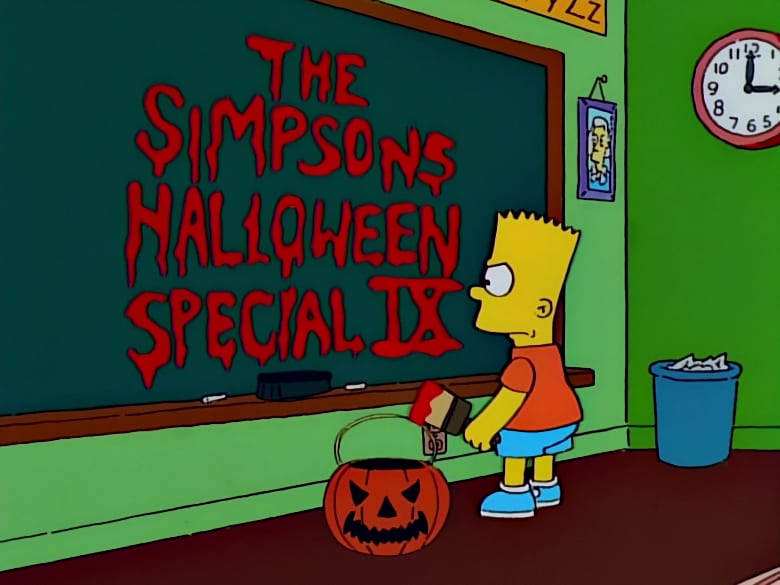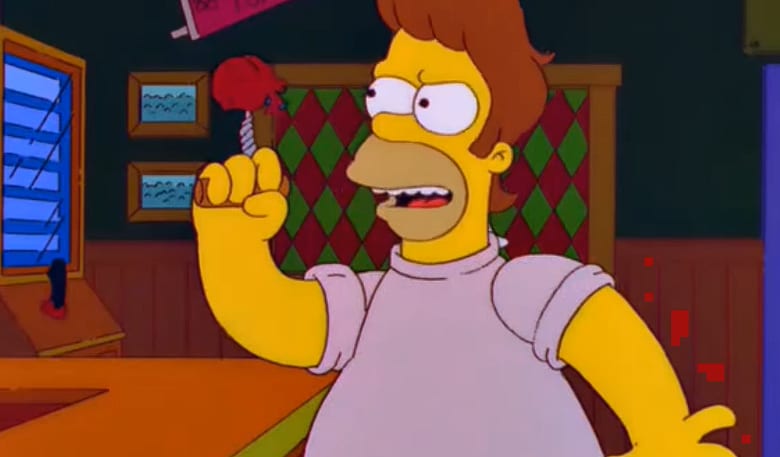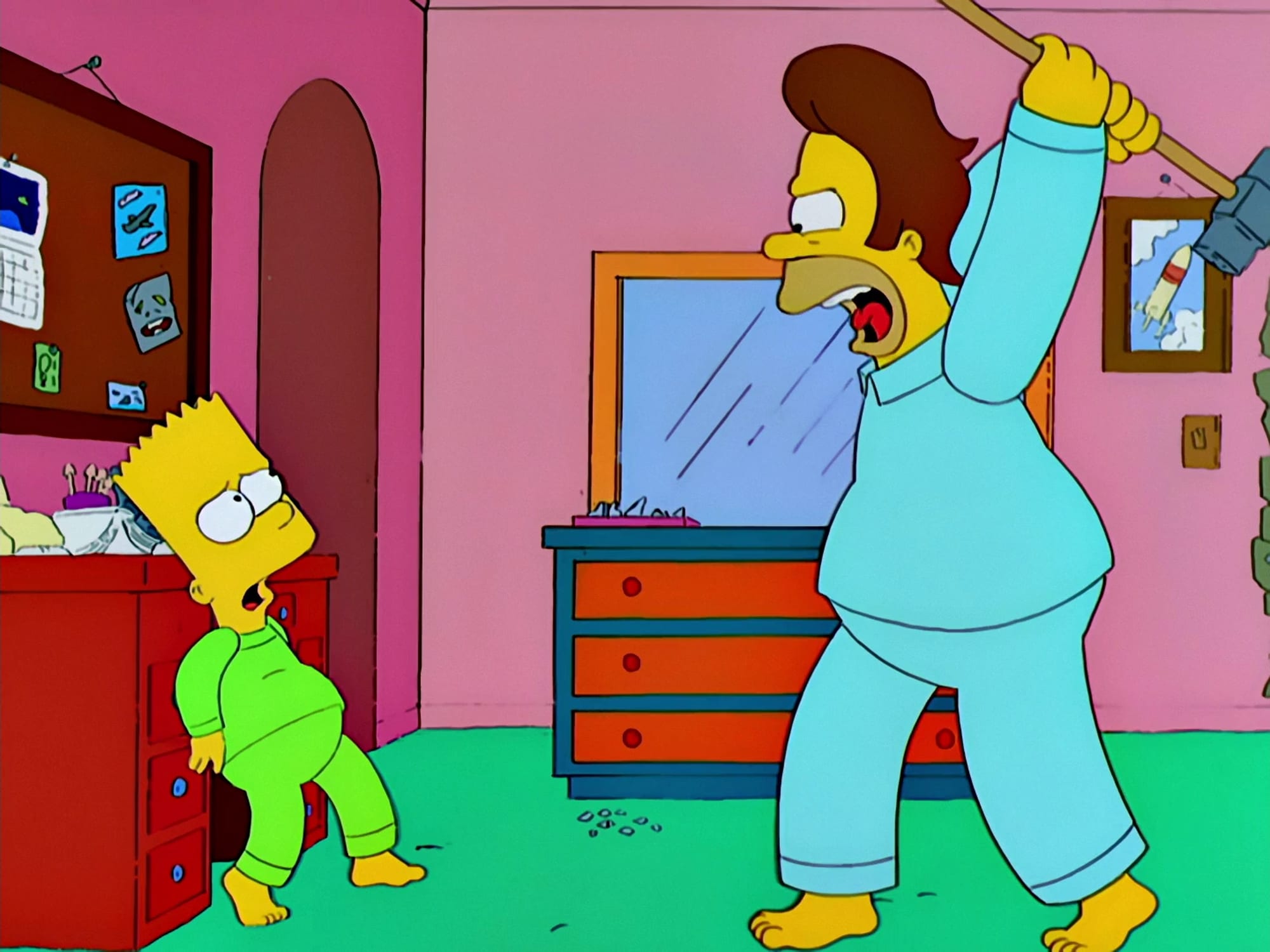“Treehouse of Horror” loves to introduce unexpected elements into The Simpsons. The Halloween-themed series of episodes always takes the most familiar aspects of the cartoon and reworks them. In the case of “Treehouse of Horror IX” and its first segment, “Hell Toupee,” one of the show’s most iconic elements is subverted: Homer’s baldness.
Okay, we’ll admit that there are a few other episodes of The Simpsons where Homer drops his cue ball look. This was first attempted in season two in “Simpson and Delilah.” But “Hell Toupee” is the only look into what would happen if Homer were to get a hair transplant. In case you haven’t seen it, we’ll spoil it for you: it doesn’t go well.
But there’s more to this segment than just the visual gag of Homer Simpson with long, flowing hair. Like all of the best “Treehouse of Horror” chapters, “Hell Toupee” pokes fun at some well-established and well-loved horror traditions and tropes. In this article, we’ll dive into the tropes that are being parodied here. But before that, let’s start with a short summary.
Summary of “Hell Toupee”
“Treehouse of Horror” is a labor of love. It’s clear that the writers of The Simpsons deeply appreciate horror, and that’s exemplified by their choice of source material for their yearly Halloween episodes. They pull from deep cuts in addition to the horror canon. This segment is based on an episode of Amazing Stories called “Hell Toupee,” and the basic idea is the exact same: a man gets a hair transplant that turns him into a murderous maniac.

Before that happens, though, The Simpsons‘ take on “Hell Toupee” is already off to a violent start. Snake, the resident criminal of Springfield, is arrested for smoking and sentenced to death. As he’s carted off, he locks eyes with Bart, who is a witness to the crime, and swears vengeance. He is then comically executed on live TV.
After this, Homer receives a call that a hair transplant has finally been found for him. Ecstatic, he goes in for the operation and receives Snake’s hair. When he comes to, he feels normal; however, that night, the hair takes control of his brain, allowing Snake to control his mind. That means bad things for Bart.
Before Snake can use Homer’s body to get revenge on Bart, though, he kills Apu and Moe, the two other witnesses. Bart then knows that he is next, so he has Homer barricade his door. This keeps all the bad guys out. Unfortunately, as Snake-Homer notes, it also keeps all the bad guys in. The mind controlled Homer then tries to kill Bart, but he’s able to fight off the possession and rip the hair off of his head.
It seems that the nightmare is over, but the hair then springs up (it apparently has a mind of its own) and tries to run away. It’s then that the police run in and take out the evil hair with a barrage of bullets. Finally, everything is back to normal, and the episode ends with a groan-worthy joke from Chief Wiggum.
Trope 1 – Mind Control
The Simpsons’ “Hell Toupee” sticks pretty close to the original Amazing Stories version, and that includes the main plot device: the mind controlling toupee. But the idea of Homer being controlled by Snake’s hair isn’t just a nod to the original “Hell Toupee.” It’s a way of parodying the trope of mind control that is seen throughout horror.
Although they rarely involve hair, there are countless movies out there where otherwise innocent people have their minds taken over by someone with evil intentions. The Manchurian Candidate is an early example, although it may be a stretch to call it horror. Scanners, a classic Cronenberg flick largely remembered for the director’s idiosyncratic body horror, also gets some of its screams from the idea of the mind being taken over.
Interestingly, this trope is often used in conjunction with politics. As the idea of war became more abstract after WWII, regular citizens started to become afraid of the idea of being brainwashed by foreign powers or sleeper cells. By the time MKUltra was revealed to the public, the idea of mind control was already being made into a legitimate and terrifying concept in cinema.
Of course, this isn’t the intention of this “Treehouse of Horror” segment. There’s not much political going on here. Instead, this kind of mind control feels more indebted to works of horror focusing on possession. Although Homer’s mind is indeed taken over by Snake’s hair, it feels more like Snake is completely possessing Homer’s body, much like we see in supernatural horror movies.
Horror shows us that there are a ton of different ways of being possessed. You can become possessed by the Devil, a demon, science, aliens, disease (zombies, anyone?), or even parasites. All of these possessors, while certainly distinct from one another, play upon the same terrifying idea: our bodies are not our own, and they can be taken from us at any moment.
Luckily, hair plugs taking over our bodies and minds is probably the least of our worries. Zombies, on the other hand… who knows.
Trope 2 – Killing from Beyond the Grave
Snake’s vow of vengeance against Bart, Apu, and Moe is something we see time and time again in horror. An evildoer is able to frighten the protagonists of the movie – and the audience – without even physically being there thanks to their vendetta. But this alone isn’t what “Hell Toupee” is getting at. The more important trope being parodied is actually that of a killer killing from beyond the grave.
Snake may be dead, but his rage is able to live on through his hair that takes over Homer’s mind. With this, he is able to continue killing even though he has been executed. It’s a theme that many horror villains use to get around expectations and appear even scarier. Even if you kill them, they won’t be stopped.

Some of the biggest villains in the entire genre are indirect examples of this trope. Annabelle always comes back, and the soul of Chucky lives on even if you destroy his body. Michael Myers and Freddy Krueger can be stopped temporarily, but they always end up continuing their killing sprees despite the heroes’ best efforts. Although these characters don’t kill while they’re dead, they’re still a great example of death being an ineffective way to defeat villains in horror.
One concrete example of a villain killing from beyond the grave is Jigsaw from Saw. Despite dying relatively early on in the series, his games continue, killing countless other individuals. And then there are villains who seem to be dead but are actually secretly alive, like Jason Voorhees.
If there’s one thing that horror has taught us, it’s that you need to make sure that the person trying to kill you is really, really dead before going back to your normal life. And even then you should probably still watch your back. They might still find a way to get you.
Trope 3 – One Final Scare
Right when we think that Homer has overcome Snake’s mind control and effectively ended the story, the hair gets up and tries to walk away. It reignites the action, but only briefly. It’s a funny moment, and it exemplifies the long standing tradition for horror movies to lull you into a false sense of security at the end of the film only to scare you one more time.
It’s an effective technique. Horror movies are all about pacing, and the best scares are the ones that you least expect. In a way, this trope of “one final scare” really only exists because it became so cliche for movies to follow a similar pace. Once all audiences got adjusted to horror movies ending the same way, a new paradigm was introduced to capitalize on that and get one more “clutch the chair” moment.
— FOUNDATIONS OF HORROR —
Further explore these subgenres & tropes. more>>
#Losing your sanity is crazy | #Comedy horror | #The Simpsons

One of the finest examples of this is the ending of Poltergeist. By the 80s, almost all major horror movies followed the same structure: idyllic beginning, rising action, terrifying climax, and peaceful resolution. But Poltergeist added its scariest scene in the midst of its resolution, and it went on to become iconic.
A precursor to this can be found in The Shining. Although the final scene is far from scary, it also subverts the audience’s expectations of having everything wrapped up and explained nicely. Rather than treating viewers to a satisfying resolution, the framed photo at the end only created more questions.
Of course, there are countless other examples of horror movies getting you with one last scare after convincing you that everything was back to normal. Final Destination 2, Carrie, and Friday the 13th all feature great final scares. It may not be very scary when the same thing happens in “Hell Toupee,” but that’s kinda the point.
Last Updated on April 29, 2022.

